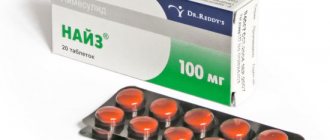Instructions for use KETONAL® (KETONAL)
The simultaneous use of Ketonal with NSAIDs, including selective COX-2 inhibitors, should be avoided.
Undesirable effects can be minimized by prescribing the drug at the minimum dose for the shortest period of time necessary to control symptoms.
Elderly patients have an increased incidence of side effects of NSAIDs, especially gastrointestinal bleeding and perforation, which can be fatal.
Gastrointestinal bleeding, ulceration or perforation with risk of death has been reported for all NSAIDs at any stage of treatment, with or without warning symptoms or a history of previous severe gastrointestinal illness.
Some epidemiological data suggest that ketoprofen may be associated with a higher risk of severe gastrointestinal toxicity compared with some other NSAIDs, especially at high doses.
In patients with a history of peptic ulcer disease, especially those complicated by bleeding or perforation, and in elderly patients, the risk of gastrointestinal bleeding, ulceration or perforation increases with increasing doses of NSAIDs. In such patients, treatment should be started with the minimum effective dose.
For these patients, as well as for patients who require concomitant use of low-dose acetylsalicylic acid or other drugs that increase the risk of gastrointestinal complications, concomitant administration of drugs that protect the gastrointestinal mucosa (for example, misoprostol or proton pump blockers) may be required.
Patients who have experienced gastrointestinal toxicity, especially elderly patients during the initial stages of treatment, should report any unusual abdominal symptoms. The risk of gastrointestinal bleeding should be kept in mind.
Caution is required when using the drug in patients receiving concomitant therapy with drugs that may increase the risk of ulcerative lesions or bleeding, for example, ingestion of corticosteroids, anticoagulants such as warfarin, selective serotonin reuptake inhibitors or antiplatelet agents such as acetylsalicylic acid.
If gastrointestinal bleeding or ulceration develops in patients receiving ketoprofen, treatment should be discontinued.
NSAIDs should be prescribed with caution to patients with a history of gastrointestinal diseases (ulcerative colitis, Crohn's disease), because their aggravation is possible.
Cardiovascular and cerebrovascular effects:
- Appropriate monitoring and consultation are required for patients with a history of hypertension and/or mild to moderate congestive heart failure, manifested by fluid retention or edema, associated with NSAID treatment.
Clinical experience and epidemiological data suggest that the use of some NSAIDs (especially at high doses and during long-term treatment) may be associated with an increased risk of arterial thrombosis (eg, myocardial infarction or stroke). There is insufficient data to exclude such a risk for ketoprofen.
In patients with uncontrolled hypertension, congestive heart failure, known coronary artery disease, peripheral arterial disease and/or cerebrovascular disease, treatment with ketoprofen should be undertaken only after careful assessment of the appropriateness of its use. Such an analysis should be done before starting long-term treatment in patients with risk factors for cardiovascular disease (for example, hypertension, hyperlipidemia, diabetes mellitus, smoking).
Patients suffering from bronchial asthma, in combination with chronic rhinitis, chronic sinusitis and/or nasal polyposis, are more likely to experience allergic reactions after taking acetylsalicylic acid and/or NSAIDs than in the general population. Administration of this product may cause an attack of bronchial asthma.
Caution is also required in patients with hemostasis disorders, hemophilia, von Willebrand disease, severe thrombocytopenia and renal or liver failure, as well as in those taking anticoagulants (coumarin and heparin derivatives, low molecular weight heparins).
In patients with liver damage receiving diuretics, after major surgical interventions with developed hypovolemia, and especially in elderly patients, urine output and renal function should be carefully monitored.
Ketoprofen should be prescribed with caution to patients with chronic alcoholism.
Severe skin reactions (some of them fatal) such as exfoliative dermatitis, Stevens-Johnson syndrome and toxic epidermal necrolysis have been observed extremely rarely in association with the use of NSAIDs. Patients are at greatest risk of developing these reactions at the beginning of treatment; in most cases, the occurrence of a reaction is noted within the first month of treatment. Ketonal® should be discontinued at the first appearance of a skin rash, changes in the mucous membranes or other signs of hypersensitivity.
As with any long-term treatment with non-steroidal antirheumatic drugs, therapy with ketoprofen requires monitoring of blood cells, as well as liver and kidney function, especially in elderly patients. When CC < 20 ml/min, dose adjustment of ketoprofen is necessary.
Like other NSAIDs, ketoprofen mask the signs and symptoms of infectious diseases.
Ketonal® should be discontinued before major surgery.
Ketonal® capsules 50 mg and Ketonal® forte contain lactose. Therefore, the drug should not be prescribed to patients with rare hereditary galactose intolerance, lactase deficiency or impaired absorption of glucose or galactose.
Ketonal® injection solution contains 12.3 vol% ethanol. Every 2 ml dose contains 0.2 g of ethanol. This may have a negative effect on patients with alcoholism, those with brain damage or disease, or pregnant or breastfeeding women.
Impact on the ability to drive vehicles and operate machinery
Patients should be warned about the possible occurrence of drowsiness, dizziness, or convulsions while taking the drug. If there is a risk of developing such reactions, patients should refrain from driving vehicles and operating machinery.
Results of preclinical safety studies
Acute toxicity. After oral administration, the LD50 of ketoprofen was 360 mg/kg in mice, 160 mg/kg in rats, and 1300 mg/kg in guinea pigs. The LD50 of ketoprofen is several times higher than that of indomethacin.
Chronic toxicity. Ketoprofen was administered orally to rats for 4 weeks at doses of 2, 6 or 18 mg/kg. 10% of animals receiving ketoprofen at a dose of 18 mg/kg died on days 6-30, some had ulceration of the intestinal mucosa. In dogs receiving the same dose, only intestinal ulcerations were described, while no animals died. Among the animals receiving indomethacin at a dose of 6 mg/kg body weight, half died; all animals receiving 18 mg/kg body weight died.
In a 6-month study, rats were administered orally ketoprofen at doses of 3, 6 or 9 mg/kg. After 8 weeks, 53% of male rats treated with 6 mg/kg and 67% of male and 20% of female rats treated with 9 mg/kg died. In animals receiving 9 mg/kg, plasma concentrations of all proteins decreased and spleen weight increased. and liver. Histopathological studies of tissues from surviving animals did not reveal significant pathological changes.
Carcinogenicity, mutagenicity and effects on fertility. Long-term toxicity studies in mice administered orally ketoprofen up to 32 mg/kg/day did not reveal carcinogenic effects of this drug. The Ames test did not show any mutagenic properties. Ketoprofen did not affect the fertility of male rats that received up to 9 mg/kg/day orally. In female rats receiving 6 or 9 mg/kg/day, the number of implantations was reduced. In male rats and dogs, suppression of spermatogenesis was found. Dogs and male monkeys treated with high doses of ketoprofen experienced a decrease in testicular weight.
Teratogenicity. Neither teratogenic effects nor effects on the fetus were shown in mice receiving ketoprofen up to 12 mg/kg/day and in rats receiving up to 9 mg/kg/day. In rabbits, doses of ketoprofen toxic to the maternal organism were embryotoxic, but had a teratogenic effect.
Ketonal
Undesirable drug combinations
The combined use of ketoprofen with other NSAIDs (including selective cyclooxygenase-2 inhibitors), salicylates in high doses is not recommended, due to the increased risk of gastrointestinal bleeding and ulceration of the gastrointestinal mucosa.
Simultaneous use with anticoagulants (heparin, warfarin), antiplatelet agents (ticlopidine, clopidogrel) increases the risk of bleeding. If the use of such a combination is unavoidable, the patient's condition should be carefully monitored.
When used simultaneously with lithium preparations, it is possible to increase the concentration of lithium in the blood plasma up to toxic values. The concentration of lithium in the blood plasma should be carefully monitored and the dose of lithium preparations should be promptly adjusted during and after treatment with NSAIDs.
Increases the hematological toxicity of methotrexate, especially when used in high doses (more than 15 mg per week). The time interval between stopping or starting therapy with ketoprofen and taking methotrexate should be at least 12 hours.
Combinations to use with caution
During therapy with ketoprofen, patients taking diuretics, especially if dehydration develops, have a higher risk of developing renal failure due to a decrease in renal blood flow caused by inhibition of prostaglandin synthesis. Before starting to use ketoprofen in such patients, rehydration measures should be carried out. After starting treatment, it is necessary to monitor kidney function.
Combined use of the drug with ACE inhibitors and angiotensin II receptor blockers in patients with impaired renal function (with dehydration, elderly patients) can lead to worsening deterioration of renal function, including the development of acute renal failure.
During the first weeks of simultaneous use of ketoprofen and methotrexate at a dose not exceeding 15 mg/week, blood tests should be monitored weekly. In elderly patients or if there are any signs of renal impairment, the study should be performed more frequently. Combinations to take into account
Ketoprofen may weaken the effect of antihypertensive drugs (beta blockers, angiotensin-converting enzyme inhibitors, diuretics).
Concomitant use with selective serotonin reuptake inhibitors (SSRIs) increases the risk of gastrointestinal bleeding.
Concomitant use with thrombolytics increases the risk of bleeding.
Concomitant use with potassium salts, potassium-sparing diuretics, ACE inhibitors, angiotensin II receptor blockers, NSAIDs, low molecular weight heparins, cyclosporine, tacrolimus and trimethoprim increases the risk of developing hyperkalemia.
When used simultaneously with cyclosporine and tacrolimus, there may be a risk of additive nephrotoxicity, especially in elderly patients.
The use of several antiplatelet drugs (tirofiban, eptifibarid, abciximab, iloprost) increases the risk of bleeding.
Increases the plasma concentration of cardiac glycosides, slow calcium channel blockers, cyclosporine, methotrexate and digoxin.
Ketoprofen may enhance the effect of oral hypoglycemic and some anticonvulsants (phenytoin).
Concomitant use with probenecid significantly reduces the plasma clearance of ketoprofen.
Nonsteroidal anti-inflammatory drugs may reduce the effectiveness of mifepristone. Taking NSAIDs should be started no earlier than 8-12 days after stopping mifepristone.
Pharmaceutically incompatible with tramadol solution due to precipitation.








